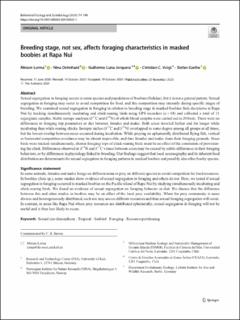| dc.contributor.author | Lerma, Miriam | |
| dc.contributor.author | Dehnhard, Nina | |
| dc.contributor.author | Luna-Jorquera, Guillermo | |
| dc.contributor.author | Voigt, Christian C. | |
| dc.contributor.author | Garthe, Stefan | |
| dc.date.accessioned | 2021-01-19T11:14:59Z | |
| dc.date.available | 2021-01-19T11:14:59Z | |
| dc.date.created | 2020-11-23T15:52:44Z | |
| dc.date.issued | 2020 | |
| dc.identifier.citation | Behavioral Ecology and Sociobiology. 2020, 74 (149), . | en_US |
| dc.identifier.issn | 0340-5443 | |
| dc.identifier.uri | https://hdl.handle.net/11250/2723654 | |
| dc.description.abstract | Sexual segregation in foraging occurs in some species and populations of boobies (Sulidae), but it is not a general pattern. Sexual
segregation in foraging may occur to avoid competition for food, and this competition may intensify during specific stages of
breeding. We examined sexual segregation in foraging in relation to breeding stage in masked boobies Sula dactylatra at Rapa
Nui by tracking simultaneously incubating and chick-rearing birds using GPS recorders (n = 18) and collected a total of 11
regurgitate samples. Stable isotope analyses (δ13C and δ15N) of whole blood samples were carried out in 20 birds. There were no
differences in foraging trip parameters or diet between females and males. Both sexes traveled farther and for longer while
incubating than while rearing chicks. Isotopic niches (δ13C and δ15N) overlapped to some degree among all groups at all times,
but the lowest overlap between sexes occurred during incubation. While preying on ephemerally distributed flying fish, vertical
or horizontal competition avoidance may be almost impossible, and thus females and males share their foraging grounds. Since
birds were tracked simultaneously, shorter foraging trips of chick-rearing birds must be an effect of the constraints of provisioning the chick. Differences observed in δ15N and δ13C values between sexes may be caused by subtle differences in their foraging
behaviors, or by differences in physiology linked to breeding. Our findings suggest that local oceanography and its inherent food
distribution are determinants for sexual segregation in foraging patterns in masked boobies and possibly also other booby species. | en_US |
| dc.language.iso | eng | en_US |
| dc.rights | Navngivelse 4.0 Internasjonal | * |
| dc.rights.uri | http://creativecommons.org/licenses/by/4.0/deed.no | * |
| dc.subject | Sexual size dimorphism | en_US |
| dc.subject | Tropical | en_US |
| dc.subject | Seabird | en_US |
| dc.subject | Foraging | en_US |
| dc.subject | Resource partitioning | en_US |
| dc.title | Breeding stage, not sex, affects foraging characteristics in masked boobies at Rapa Nui | en_US |
| dc.type | Peer reviewed | en_US |
| dc.type | Journal article | en_US |
| dc.description.version | publishedVersion | en_US |
| dc.rights.holder | The Author(s) 2020 | en_US |
| dc.subject.nsi | VDP::Matematikk og Naturvitenskap: 400::Zoologiske og botaniske fag: 480 | en_US |
| dc.source.pagenumber | 16 | en_US |
| dc.source.volume | 74 | en_US |
| dc.source.journal | Behavioral Ecology and Sociobiology | en_US |
| dc.source.issue | 149 | en_US |
| dc.identifier.doi | 10.1007/s00265-020-02921-1 | |
| dc.identifier.cristin | 1851203 | |
| dc.relation.project | Research and Technology Centre (FTZ), University of Kiel | en_US |
| dc.source.articlenumber | 149 (2020) | en_US |
| cristin.ispublished | true | |
| cristin.fulltext | original | |
| cristin.qualitycode | 1 | |

